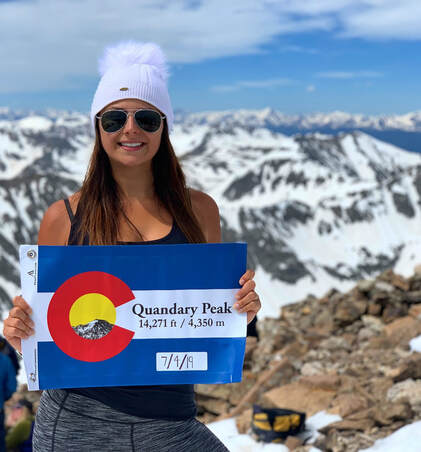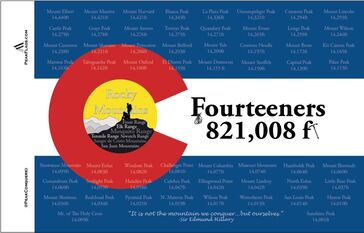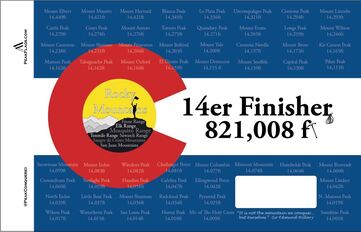Colorado is the home of Peak Flags! It was our 14ers that inspired our start and we thought it would be a great way to not only provide a great way to commemorate your achievement, but a way to preserve our mountains and promote Leave Not Trace by providing an alternative to cardboard signs.

Colorado is notable for its diverse geography, which includes alpine mountains, high plains, deserts with huge sand dunes, and deep canyons.
To the west of the Great Plains of Colorado rises the eastern slope of the Rocky Mountains. Notable peaks of the Rocky Mountains include Longs Peak, Mount Evans, Pikes Peak, and the Spanish Peaks near Walsenburg, in southern Colorado. This area drains to the east and the southeast, ultimately either via the Mississippi River or the Rio Grande into the Gulf of Mexico.
The Rocky Mountains within Colorado contain 58 peaks that are 14,000 feet (4,267 m) or higher in elevation above sea level, known as fourteeners. These mountains are largely covered with trees such as conifers and aspens up to the tree line, at an elevation of about 12,000 ft (3,658 m) in southern Colorado to about 10,500 ft (3,200 m) in northern Colorado. Above this tree line only alpine vegetation grows. Only small parts of the Colorado Rockies are snow-covered year-round.
Much of the alpine snow melts by mid-August with the exception of a few snow-capped peaks and a few small glaciers. The Colorado Mineral Belt, stretching from the San Juan Mountains in the southwest to Boulder and Central City on the front range, contains most of the historic gold- and silver-mining districts of Colorado. Mount Elbert is the highest summit of the Rocky Mountains. The 30 highest major summits of the Rocky Mountains of North America all lie within the state.
For an official complete PDF list of Colorado's Fourteeners and elevations click here.
To the west of the Great Plains of Colorado rises the eastern slope of the Rocky Mountains. Notable peaks of the Rocky Mountains include Longs Peak, Mount Evans, Pikes Peak, and the Spanish Peaks near Walsenburg, in southern Colorado. This area drains to the east and the southeast, ultimately either via the Mississippi River or the Rio Grande into the Gulf of Mexico.
The Rocky Mountains within Colorado contain 58 peaks that are 14,000 feet (4,267 m) or higher in elevation above sea level, known as fourteeners. These mountains are largely covered with trees such as conifers and aspens up to the tree line, at an elevation of about 12,000 ft (3,658 m) in southern Colorado to about 10,500 ft (3,200 m) in northern Colorado. Above this tree line only alpine vegetation grows. Only small parts of the Colorado Rockies are snow-covered year-round.
Much of the alpine snow melts by mid-August with the exception of a few snow-capped peaks and a few small glaciers. The Colorado Mineral Belt, stretching from the San Juan Mountains in the southwest to Boulder and Central City on the front range, contains most of the historic gold- and silver-mining districts of Colorado. Mount Elbert is the highest summit of the Rocky Mountains. The 30 highest major summits of the Rocky Mountains of North America all lie within the state.
For an official complete PDF list of Colorado's Fourteeners and elevations click here.
Colorado 14er Peak Flags
Buy any 3 Colorado 14er Peak Flags and get the above 'Colorado 14ers' flag free!*
*No code necessary. Flag will be automatically shipped with your order of three or more Colorado Peak Flags.
All 58 14er Peak Flags and a 14er Finisher Peak Flag.


